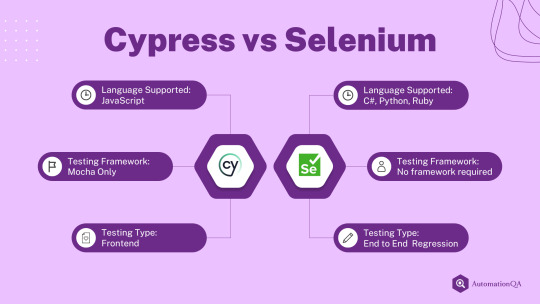#web application testing tools
Explore tagged Tumblr posts
Text
AI-Powered Testing Tools: Smarter, Faster, Better QA
In today's fast-paced development cycles, QA teams are under pressure to deliver flawless software at speed. Traditional test automation struggles to keep up with rapidly evolving codebases and complex architectures. That’s where AI-powered testing tools step in—offering a smarter, faster, and more adaptive approach to quality assurance.
These tools go beyond basic automation by using artificial intelligence and machine learning to optimize the entire testing lifecycle. From identifying high-impact test cases to auto-generating scripts and predicting potential defects, AI enhances both accuracy and efficiency. API automation testing tools like Testim, Mabl, Functionize, and Applitools are at the forefront, delivering intelligent test coverage, self-healing capabilities, and visual UI testing powered by AI.
What makes these tools game-changing is their ability to learn from data, adapt to changes in real time, and drastically reduce test maintenance efforts. Teams can focus more on strategy and less on manual effort, accelerating release cycles without compromising on quality.
In this blog, we’ll explore how AI is reshaping QA, key features to look for in AI-powered tools, and why forward-thinking teams are embracing this shift to deliver better software, faster.
#ai automation testing tools#api automation tools#ai automation testing#api automation testing tools#codeless test automation#qa automation#web application testing tools#application testing tools
0 notes
Text
Web Application Testing Tools
In today’s digital age, web applications play a critical role in various aspects of our lives, from online shopping and banking to social networking and business operations. Ensuring the performance, security, and reliability of these web applications is paramount. This is where web application testing tools come into play. They help developers and testers identify and fix issues before they…
0 notes
Text
Automated Testing Tools For Web Applications | FireFlink
Scriptless automated testing tools for full-stack web applications ! Focus on developing test scripts in plain English instead of complex coding! Sign up for free!
Visit Website: Automated Testing Tools For Web Applications
0 notes
Text

How to Balance Fixing Performance Issues and Adding New Features in Web Applications?
In today’s digital landscape, web applications are essential for business operations, marketing, and consumer involvement. As organizations expand and consumer expectations rise, development teams are frequently confronted with the difficult task of balancing two key priorities: addressing performance issues and introducing new features.
While boosting performance improves the user experience and increases efficiency, new features are required to remain competitive and meet market demands. Prioritizing one over the other, on the other hand, might have negative consequences—performance concerns can lead to a poor user experience while failing to innovate can result in a competitive disadvantage.
This blog delves into how to balance improving performance and introducing new features to web apps, allowing firms to satisfy technical and market demands efficiently.
Why Balancing Performance and New Features Is Crucial
A web application‘s success depends on both its performance and its features. However, relying entirely on one might result in imbalances that impair both user happiness and business progress.
Performance:Performance is an important component that directly influences user retention and happiness. Users can become frustrated and leave if the application has slow loading times, crashes, or problems. Ensuring that your web application runs smoothly is essential since 53% of mobile consumers would quit a site that takes more than three seconds to load.
New Features:On the other hand, constantly adding new features keeps users interested and promotes your company as innovative. New features generate growth by attracting new consumers and retaining existing ones who want to experience the most recent changes.
The dilemma is deciding when to prioritize bug fixes over new feature development. A poor balance can harm both performance and innovation, resulting in a subpar user experience and stagnation.
Common Performance Issues in Web Applications
Before balancing performance and features, it’s important to understand the common performance issues that web applications face:
Slow Load Times: Slow pages lead to higher bounce rates and lost revenue.
Server Downtime: Frequent server outages impact accessibility and trust.
Poor Mobile Optimization: A significant portion of web traffic comes from mobile devices and apps that aren���t optimized for mobile fail to reach their potential.
Security Vulnerabilities: Data breaches and security flaws harm credibility and user trust.
Bugs and Glitches: Software bugs lead to poor user experiences, especially if they cause the app to crash or become unresponsive.
Strategic Approaches to Fixing Performance Issues
When performance issues develop, they must be handled immediately to guarantee that the online application functions properly. Here are techniques for improving performance without delaying new feature development:
Prioritize Critical Issues:Tackle performance issues that have the most significant impact first, such as slow loading times or security vulnerabilities. Use analytics to identify bottlenecks and determine which areas require urgent attention.
Use a Continuous Improvement Process:Continuously monitor and optimize the application’s performance. With tools like Google PageSpeed Insights, you can track performance metrics and make incremental improvements without major overhauls.
Optimize Database Queries:Slow database queries are one of the leading causes of web app performance issues. Optimize queries and ensure that the database is indexed properly for faster access and retrieval of data.
Reduce HTTP Requests:The more requests a page makes to the server, the slower it loads. Minimize requests by reducing file sizes, combining CSS and JavaScript files, and utilizing caching.
5. Leverage Caching and CDNs: Use caching strategies and Content Delivery Networks (CDNs) to deliver content quickly to users by storing files in multiple locations globally.
Why Adding New Features is Essential for Growth
In the rapidly changing digital environment, businesses must continually innovate to stay relevant. Adding new features is key to maintaining a competitive edge and enhancing user engagement. Here’s why:
User Expectations:Today’s consumers expect personalized experiences and constant innovation. Failure to add new features can lead to customer churn, as users may feel your web application no longer meets their needs.
Market Differentiation:Introducing new features allows your application to stand out in the marketplace. Unique functionalities can set your app apart from competitors, attracting new users and increasing customer loyalty.
Increased Revenue Opportunities:New features can lead to additional revenue streams. For example, adding premium features or new integrations can boost the app’s value and lead to increased sales or subscription rates.
4. Feedback-Driven Innovation: New features are often driven by user feedback. By continuously developing and adding features, you create a feedback loop that improves the overall user experience and fosters customer satisfaction.
Read More: https://8techlabs.com/how-to-balance-fixing-performance-issues-and-adding-new-features-in-web-applications-to-meet-market-demands-and-enhance-user-experience/
#8 Tech Labs#custom software development#custom software development agency#custom software development company#software development company#mobile app development software#bespoke software development company#bespoke software development#nearshore development#software development services#software development#Website performance testing tools#Speed optimization for web apps#Mobile-first web app optimization#Code minification and lazy loading#Database indexing and query optimization#Agile vs Waterfall in feature development#Feature flagging in web development#CI/CD pipelines for web applications#API performance optimization#Serverless computing for better performance#Core Web Vitals optimization techniques#First Contentful Paint (FCP) improvement#Reducing Time to First Byte (TTFB)#Impact of site speed on conversion rates#How to reduce JavaScript execution time#Web application performance optimization#Fixing performance issues in web apps#Web app performance vs new features#Website speed optimization for better UX
0 notes
Text
WP Engine is a well-known managed WordPress hosting provider.
It offers a range of features and services tailored specifically for WordPress websites, making it a popular choice among businesses, bloggers, and developers who seek reliable, high-performance hosting solutions.

#Managed WordPress Hosting:#security#and reliability.#automated updates#and staging environments.#Genesis Framework and StudioPress Themes:#Access to the Genesis Framework for building fast#secure#and SEO-friendly websites.#Includes over 35 StudioPress themes for customization and design flexibility.#Global Edge Security:#Advanced security features including DDoS protection and Web Application Firewall (WAF).#Managed threat detection and prevention.#Content Performance:#Tools and analytics to measure and optimize content performance.#Helps improve site speed and SEO rankings.#Dev#Stage#Prod Environments:#Separate development#staging#and production environments for better workflow management.#Allows for testing changes before pushing them live.#Automated Migrations:#Easy migration tools to transfer existing WordPress sites to WP Engine.#Assisted migrations for a smoother transition.#24/7 Customer Support:
0 notes
Text
what is Embedded Software Testing?
Embedded software testing refers to the process of evaluating and validating the software running on embedded systems. Embedded systems are specialized computer systems designed to perform specific functions within larger devices or machinery. They are typically found in various applications such as automobiles, medical devices, consumer electronics, industrial equipment, and more.
Embedded software testing involves assessing the functionality, reliability, performance, and safety of the software that operates these embedded systems. The testing process aims to identify defects, errors, and vulnerabilities within the software, ensuring that it meets the desired specifications and requirements.
Some common types of testing techniques used in embedded software testing include:
Unit Testing: Testing individual components or modules of the software to ensure they function correctly.
Integration Testing: Verifying the proper interaction and communication between different software modules within the embedded system.
System Testing: Evaluating the overall functionality and behavior of the entire embedded system, including the software and hardware components.
Performance Testing: Assessing the performance and responsiveness of the embedded software under different conditions and loads.
Security Testing: Identifying vulnerabilities and weaknesses in the software to protect against potential security threats and breaches.
Regression Testing: Repeatedly testing the software to ensure that recent changes or updates have not introduced new defects or caused any regressions.
Usability Testing: Evaluating the user-friendliness and ease of use of the embedded software interface.
Safety Testing: Assessing the software's compliance with safety standards and ensuring it operates reliably to prevent any potential harm or accidents.
Embedded software testing requires specialized knowledge and expertise due to the unique challenges posed by the embedded systems' hardware limitations, real-time constraints, and specific application requirements. Testers often use a combination of manual testing techniques and automated testing tools to thoroughly assess the embedded software's quality and functionality.
For More, You Can Visit This Post: Embedded Software Testing: Ensuring Quality and Reliability
Robonito Is a no-code automation testing tool for software and web apps that can automate your software testing
#software testing#testing#web application#no code automation testing tool#software testing tool#robonito#RPA
0 notes
Text

🔍 Searching for the perfect testing tool for your web app?
🤔 Check out our comparison of Cypress vs Selenium to help you make the right choice! ����
1 note
·
View note
Text







Top AngularJS Development Tools AngularJS development tools are software applications that aid developers in building, testing, and debugging web applications using the AngularJS framework. They provide features like code editing, live reloading, component inspection, and performance analysis to streamline the development process and enhance productivity. . . ➡️Check out the post to learn more about them. ➡️Let us know if you want to know more points in the comment section below 👉Do not forget to share with someone whom it is needed. 👉Let us know your opinion in the comment down below 👉Follow @Zoof Software Solutions for more information ➡Grow your business with us! . . ✔️Feel free to ask any query at [email protected] ✔️For more detail visit: https://zoof.co.in/
#Top AngularJS Development Tools#AngularJS development tools are software applications that aid developers in building#testing#and debugging web applications using the AngularJS framework. They provide features like code editing#live reloading#component inspection#and performance analysis to streamline the development process and enhance productivity.#.#➡️Check out the post to learn more about them.#➡️Let us know if you want to know more points in the comment section below#👉Do not forget to share with someone whom it is needed.#👉Let us know your opinion in the comment down below#👉Follow @Zoof Software Solutions for more information#➡Grow your business with us!#✔️Feel free to ask any query at [email protected]#✔️For more detail visit: https://zoof.co.in/#AngularJS#AngularJSDevelopment#javascript#application#developers#coder#angular#angularjs#angulardeveloper#programmer#angularjsdevelopmenttools#AngularJSTools#angularframework#AngularJSFramework
1 note
·
View note
Text
Essentials You Need to Become a Web Developer
HTML, CSS, and JavaScript Mastery
Text Editor/Integrated Development Environment (IDE): Popular choices include Visual Studio Code, Sublime Text.
Version Control/Git: Platforms like GitHub, GitLab, and Bitbucket allow you to track changes, collaborate with others, and contribute to open-source projects.
Responsive Web Design Skills: Learn CSS frameworks like Bootstrap or Flexbox and master media queries
Understanding of Web Browsers: Familiarize yourself with browser developer tools for debugging and testing your code.
Front-End Frameworks: for example : React, Angular, or Vue.js are powerful tools for building dynamic and interactive web applications.
Back-End Development Skills: Understanding server-side programming languages (e.g., Node.js, Python, Ruby , php) and databases (e.g., MySQL, MongoDB)
Web Hosting and Deployment Knowledge: Platforms like Heroku, Vercel , Netlify, or AWS can help simplify this process.
Basic DevOps and CI/CD Understanding
Soft Skills and Problem-Solving: Effective communication, teamwork, and problem-solving skills
Confidence in Yourself: Confidence is a powerful asset. Believe in your abilities, and don't be afraid to take on challenging projects. The more you trust yourself, the more you'll be able to tackle complex coding tasks and overcome obstacles with determination.
#code#codeblr#css#html#javascript#java development company#python#studyblr#progblr#programming#comp sci#web design#web developers#web development#website design#webdev#website#tech#html css#learn to code
2K notes
·
View notes
Text
How to Deal with Windows 10/11 Nonsense
This is more for my own reference to keep all of this on one post. But hopefully others will find this useful too! So yeah, as the title says, this is a to organize links and resources related to handling/removing nonsense from Windows 10 and Windows 11. Especially bloatware and stuff like that Copilot AI thing.
First and foremost, there's O&O Software's ShutUp10++ (an antispy tool that help give you more control over Windows settings) and App Buster (helps remove bloatware and manage applications). I've used these myself for Windows 10 and they work great, and the developers have stated that these should work with Windows 11 too!
10AppsManager is another bloatware/app management tool, though at the moment it seems to only work on Windows 10.
Winaero Tweaker, similar to ShupUp10++ in that it gives you more control over Windows to disable some of the more annoying settings, such as disabling web search from the taskbar/start menu and disabling ads/tips/suggestions in different parts of the OS. I think ShupUp10++ covers the same options as this one, but I'm not entirely sure.
OpenShell, helps simplify the Start Menu and make it look more like the classic start menu from older versions of Windows. Should work with both 10 and 11 according to the readme.
Notes on how to remove that one horrible AI spying snapshots feature that's being rolled out on Windows 11 right now.
Article on how to remove Copilot (an AI assistant) from Windows 11. (Edit 11/20/2024) Plus a post with notes on how to remove it from Windows 10 too, since apparently it's not just limited to 11 now.
Win11Debloat, a simple script that can be used to automatically remove pretty much all of the bullshit from both 10 and 11, though a lot of its features are focused on fixing Windows 11 in particular (hence the name). Also has options you can set to pick and choose what changes you want!
Article on how to set up Windows 11 with a local account on a new computer, instead of having to log in with a Microsoft account. To me, this is especially important because I much prefer having a local account than let Microsoft have access to my stuff via a cloud account. Also note this article and this article for more or less the same process.
I will add to this as I find more resources. I'm hoping to avoid Windows 11 for as long as possible, and I've already been used the O&O apps to keep Windows 10 trimmed down and controlled. But if all else fails and I have to use Windows 11 on a new computer, then I plan to be as prepared as possible.
Edit 11/1/2024: Two extra things I wanted to add onto here.
A recommended Linux distro for people who want to use Linux instead of Windows.
How to run a Windows app on Linux, using Wine. Note that this will not work for every app out there, though a lot of people out there are working on testing different apps and figuring out how to get them to work in Wine.
The main app I use to help with my art (specifically for 3D models to make references when I need it) is Windows only. If I could get it to work on Linux, it would give me no reason to use Windows outside of my work computer tbh (which is a company laptop anyways).
377 notes
·
View notes
Text
STARKSTRESSER -PLATİN

In a digital landscape where stability and performance are paramount, StarkStresser offers cutting-edge solutions designed to elevate your online presence. Whether you are a gamer seeking a competitive edge or a developer ensuring robust application performance, our comprehensive suite of tools—including advanced IP stressers and free IP booters—caters to a multitude of needs. With a focus on delivering seamless connectivity and unparalleled reliability, StarkStresser empowers users to effectively test their networks under simulated conditions.
Stresser
A stresser is an online tool designed primarily for testing the resilience of networks and servers against various types of attacks. It simulates Distributed Denial of Service (DDoS) attacks, which can overwhelm a server by flooding it with traffic, and it is crucial for organizations to understand how resilient their infrastructure is to such threats. Using a stresser can help businesses identify vulnerabilities in their systems and improve security measures.
However, it's essential to note that the ethical use of stress testing tools is paramount. Users should only test devices and networks they own or have explicit permission to test. Misuse of a stresser can lead to legal consequences, including potential fines and imprisonment.
When searching for a reliable ip stresser, it’s vital to look for one that provides clear usage guidelines and supports ethical considerations. Many reputable services also offer features that allow users to simulate attacks within controlled environments, enabling businesses to prepare better for real-world cyber threats.
In the realm of cybersecurity, understanding the capabilities of a stresser can empower organizations to actively defend against potential attacks. Be sure to research any selected tool thoroughly, ensuring it aligns with your security testing needs and ethical standards.
Ip Stresser
An IP stresser is a tool or service designed to test the resilience of a network or website against various types of stress attacks. Often utilized by web administrators and security professionals, an IP stresser can simulate considerable traffic to help evaluate the potential vulnerabilities of a specific IP address or server. This testing can help organizations strengthen their defenses against actual malicious attacks.
However, it is crucial to note that the use of an ip stresser should always be conducted ethically and legally. Using it to attack or disrupt services without authorization is illegal and can lead to severe consequences. Always ensure you have the necessary permissions to conduct such tests on a network or system.
In the context of stress testing, there are various types of IP stressers available, which can differ in their methods and intensity. Some users prefer IP stressers that offer adjustable parameters to customize the attack, while others might seek those with user-friendly interfaces that can deliver quick results.
Another vital aspect to consider is the choice between premium and free IP stressers. While free versions can be tempting due to their no-cost nature, they often come with limitations in terms of performance and reliability. Paid options typically provide more robust features, better support, and a more reliable service, making them suitable for serious testing purposes.
As you explore various IP stressers, it’s essential to choose one that aligns with your specific needs, whether you're looking for free solutions or comprehensive paid services. Always prioritize using reputable services to ensure that your testing complies with legal requirements and ethical standards.
Ip Stresser Free
When it comes to stress testing your server or network, finding an ip stresser free option can be appealing for many users. Free IP stress testing services, commonly known as stresser tools, offer a way for individuals to test the resilience of their networks without incurring any costs. However, it is crucial to be aware of the risks and limitations associated with these free options.
These services typically have a limited capacity compared to their paid counterparts, which may restrict the intensity of the tests you can perform. Users should also consider the legality and ethical implications of using such tools, as testing without permission can result in significant legal troubles.
Moreover, relying on an ip booter or free stresser might expose your network to potential vulnerabilities, including the risk of data breaches or exposure to malicious attacks. Therefore, it’s advisable to conduct thorough research and choose reputable providers when selecting an ip stresser free option.
In conclusion, while free stresser tools might seem like an appealing solution, always prioritize security and legality by using these tools responsibly and considering paid services for more comprehensive testing solutions.
Ip Booter
An IP booter is a specialized tool designed to perform Distributed Denial of Service (DDoS) attacks by overwhelming a specific target IP address with excessive traffic. The idea is to disrupt the target's online services, making them unavailable for legitimate users. Booters have gained popularity in certain circles, particularly within gaming communities, where individuals seek to retaliate against others by interrupting their connection.
It's important to distinguish between legitimate use and malicious intent. There are instances where individuals may seek to test the robustness of their own networks or those for whom they have explicit permission. However, the use of IP booters against unsuspecting targets is generally illegal and unethical. Many countries have strict laws against unauthorized DDoS attacks, which can lead to severe penalties.
In addition to the ethical concerns, users should be wary of utilizing free ip booter, as they often compromise security. Free services may expose users to malware, phishing attempts, and data breaches. For those considering a stresser or IP stresser, prioritizing reputable and secure services is crucial, ensuring that they comply with legal standards and best practices in cybersecurity.
In conclusion, while the allure of using an IP booter may be tempting, it is essential to recognize the potential consequences—both legally and ethically. Responsible internet usage and adherence to laws protect not only individuals but the entire online community.
993 notes
·
View notes
Text
Avoiding Common Pitfalls in App Test Automation: Lessons from the Field
App test automation can dramatically improve testing speed, accuracy, and coverage—but only if done right. Many teams dive in with enthusiasm, only to hit roadblocks that slow them down or lead to flaky, hard-to-maintain test suites.
This blog highlights common pitfalls seen in real-world projects and how to avoid them. From choosing the wrong tools for your app type (e.g., using web-focused frameworks for native apps) to over-automating unstable features, we’ll explore mistakes that cost time and resources.
We'll share lessons on poor test design, such as hard-coded waits, unoptimized locators, and lack of modular test architecture, which often lead to fragile scripts. Another key issue we'll address is skipping proper test data management and failing to clean up after test runs—both of which can lead to inconsistent results.
Additionally, we’ll cover challenges like not integrating tests into CI/CD early enough, neglecting test reporting, or ignoring test flakiness. Each pitfall will be paired with a solution or best practice drawn from real QA experiences.
By learning from these common mistakes, you can strengthen your automation efforts and build a more reliable, scalable testing process—faster and smarter.
#automation testing#no code test automation#codeless test automation#api automation#api automation testing tools#test data management#cross browser testing tools#web application testing tools
0 notes
Text
Ensuring the performance, security, and reliability of these web applications is paramount. This is where web application testing tools come into play. They help developers and testers identify and fix issues before they become critical, ensuring a seamless user experience. In this blog, we will explore some of the top web application testing tools and how they can benefit your development process. Additionally, we will introduce you to Testscenario, a leading provider of comprehensive web application testing tools.
0 notes
Text
Application Server Automation & Testing
For websites containing a lot of JavaScript, AJAX, or Java applets, developers need a mechanism to ensure that these programs execute smoothly. Anyone can use the EveryStep Web Recorder to create testing and monitoring scripts that can perform complex actions, such as filling out forms and interacting with multimedia content—even for complex elements such as Silverlight or Java Applets, thanks to the EveryStep tool's RIA (Rich Internet Application). These scripts may then be imported into the UserView platform for monitoring, ensuring that the apps load properly and clients get the best possible experience.
Web app automation testing tools security is a subset of information security (InfoSec) that addresses the security of websites, apps, and web services. The difficult objective of information security is to strike a balance between confidentiality, integrity, and data availability while minimizing productivity loss.
Cross-site scripting, or XSS, is one of the most prevalent forms of web application assaults in which an attacker injects malicious code into a site by impersonating a trustworthy source or stealing cookies and unintentionally sending visitors to a different page.
#web app automation testing tools#best automation testing tool for web applications#web testing tools
0 notes
Text
That post from like a month ago (I was planning to write this the day after and then immediately forgot and this has been in drafts since lol) about web devs not having some basic knowledge of the web has been stuck in my brain for a while because they are correct as I said in the notes but it's the landscape of web dev right now that's causing it and I don't see it stopping anytime soon.
I've been a professional Front End Dev for just over 7 years at this point (now a UX Dev working on a design system), and while I have a good chunk of experience under my belt, I've gotten to the point where I realize just how much shit I do not know and it's a LOOOOT.
The current landscape of web dev is that most projects and products are robust web apps that, in the absolute best case scenario, are gonna require, at minimum:
User experience research and work (UX)
User interface design (UI)
Front end with accessibility and mobile responsiveness (I am here)
Front end interactions and state management (JS engineers)
Backend database and API work
Backend infrastructure work (including setting up the dev and QA test environments)
QA testing
Developer experience to make sure devs/engineers are working efficiently with the tools they have
I'm sure I've missed some roles here, but you can see why people end up specializing when they work on bigger projects and products. The web is so unbelievably JavaScript heavy nowadays that all these specializations are Kind Of Required™, but that's absolute best case scenario. A lot of companies simply do not have the budget (or desire) to fill all these roles. So then you have a bunch of people who are kinda okay to mediocre at multiple of these things instead focusing on being good at one or two things. And then put in timeline requirements. AND THEN you have some companies who have different philosophies on how to build their core product: some are very UX focused and will put time into making sure that's present, others are not and will not care about UX in the slightest and thus those roles may not exist there at all. And...well things aren't going to be as quality as you expect when you consider all of those points.
The web is full of applications now that require a lot more expertise in different fields than just a basic static site with no data. That's not to say static sites don't exist or have no place anymore, tho. But this is where we are. It sucks.
#web#web dev#web development#front end development#back end development#ui design#ux design#html#CSS#JavaScript#career
9 notes
·
View notes
Text
How to Build Software Projects for Beginners

Building software projects is one of the best ways to learn programming and gain practical experience. Whether you want to enhance your resume or simply enjoy coding, starting your own project can be incredibly rewarding. Here’s a step-by-step guide to help you get started.
1. Choose Your Project Idea
Select a project that interests you and is appropriate for your skill level. Here are some ideas:
To-do list application
Personal blog or portfolio website
Weather app using a public API
Simple game (like Tic-Tac-Toe)
2. Define the Scope
Outline what features you want in your project. Start small and focus on the minimum viable product (MVP) — the simplest version of your idea that is still functional. You can always add more features later!
3. Choose the Right Tools and Technologies
Based on your project, choose the appropriate programming languages, frameworks, and tools:
Web Development: HTML, CSS, JavaScript, React, or Django
Mobile Development: Flutter, React Native, or native languages (Java/Kotlin for Android, Swift for iOS)
Game Development: Unity (C#), Godot (GDScript), or Pygame (Python)
4. Set Up Your Development Environment
Install the necessary software and tools:
Code editor (e.g., Visual Studio Code, Atom, or Sublime Text)
Version control (e.g., Git and GitHub for collaboration and backup)
Frameworks and libraries (install via package managers like npm, pip, or gems)
5. Break Down the Project into Tasks
Divide your project into smaller, manageable tasks. Create a to-do list or use project management tools like Trello or Asana to keep track of your progress.
6. Start Coding!
Begin with the core functionality of your project. Don’t worry about perfection at this stage. Focus on getting your code to work, and remember to:
Write clean, readable code
Test your code frequently
Commit your changes regularly using Git
7. Test and Debug
Once you have a working version, thoroughly test it. Look for bugs and fix any issues you encounter. Testing ensures your software functions correctly and provides a better user experience.
8. Seek Feedback
Share your project with friends, family, or online communities. Feedback can provide valuable insights and suggestions for improvement. Consider platforms like GitHub to showcase your work and get input from other developers.
9. Iterate and Improve
Based on feedback, make improvements and add new features. Software development is an iterative process, so don’t hesitate to refine your project continuously.
10. Document Your Work
Write documentation for your project. Include instructions on how to set it up, use it, and contribute. Good documentation helps others understand your project and can attract potential collaborators.
Conclusion
Building software projects is a fantastic way to learn and grow as a developer. Follow these steps, stay persistent, and enjoy the process. Remember, every project is a learning experience that will enhance your skills and confidence!
3 notes
·
View notes